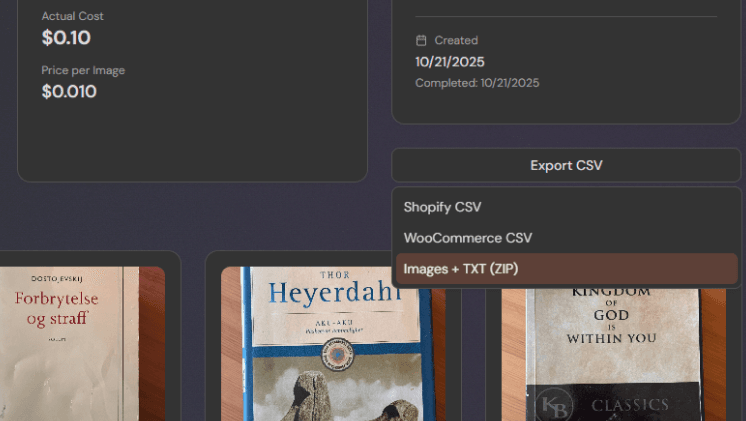Turning Book Waste Into Value: How AI Can Save Thousands of Books from Destruction

Picture this: A family clearing out their elderly parent's home arrives at the recycling center with boxes full of books. Classics, novels, cookbooks, travel guides—many in excellent condition, some barely touched. The staff glances at the volumes, notes they're books, and directs them to the paper waste container.
Within days, they're destroyed.
This scene repeats itself at recycling facilities worldwide every single day. Whether operated by local authorities, municipalities, or private waste management companies, these centers face the same challenge: thousands of perfectly saleable books end up destroyed simply because processing them manually is impractical.
The Book Waste Problem
The Scale
The numbers are staggering. Estate clearances alone can deliver 200-500 books in a single drop-off. Add downsizing moves, library deaccessioning, and institutional cleanouts, and even medium-sized facilities process thousands of books monthly.
Most are in readable condition. Many could sell for €3-8 each. Some are rare editions worth considerably more.
Yet the vast majority never get that chance.
Why It Happens
It's not that recycling center operators don't see the potential value. They do. But traditional book processing creates an impossible bottleneck:
- Manual cataloging takes too long: Typing in titles, authors, ISBNs, and conditions for hundreds of books per week simply isn't feasible with existing staff
- Pricing requires expertise: Without knowing market values, it's hard to decide which books justify the effort
- Storage space is limited: Books can't sit indefinitely while waiting to be processed
- Sales channels need management: Getting books to market requires inventory systems and marketplace accounts
Faced with these barriers, the rational choice becomes destruction. Even when revenue and environmental benefits are obvious, the operational reality makes recovery impractical.
Until now.
The AI Solution: From Camera to Catalog in Minutes
Artificial intelligence has transformed what's possible in book recovery. What once took hours of manual data entry now happens automatically from a simple photograph.
Here's how modern AI-powered systems work:
1. Take Photos
Staff photograph book covers using any smartphone. No special equipment, no complex setup—just clear photos of the covers.
- Speed: 100 books in 15-20 minutes
- Skills needed: If you can take a smartphone photo, you can do this
- Equipment: Any recent smartphone (2020+)
2. AI Does the Work
Upload photos and the AI system automatically:
- Reads titles and authors from cover images using computer vision
- Identifies ISBNs, editions, and publishers through visual recognition
- Estimates market values based on real-time marketplace data
- Detects language and condition indicators automatically
Processing time: Minutes, regardless of batch size.
3. Export and Sell
The system generates ready-to-upload catalog files for:
- Online book marketplaces (CSV format)
- Local bookstore wholesale partnerships
- Internal inventory systems
- Charity donation documentation
From photograph to marketplace listing in minutes instead of hours.
You Can Start Today
Book01 is already available for recycling centers to use. While we're developing specialized features tailored for waste management operations, the core functionality you need is ready now.
Simple Text Export Included
The current system exports book information in multiple formats, including a simple text file format perfect for getting started without complex integrations.
- Share with wholesale book buyers
- Use for inventory documentation
- Copy and paste book and title information to craigslist or other platforms
- Process with simple spreadsheet tools

The Opportunity
Financial Impact
Even modest recovery rates create measurable revenue:
- 100 books per week recovered = 5,200 books annually
- €3-8 average value = €15,600-41,600 potential annual revenue
- Staff time required: 1-4 hours per week with AI processing
This doesn't include occasional high-value finds—first editions, collector's items, or out-of-print titles that can command significantly higher prices.
Environmental Impact
Book recovery delivers concrete sustainability benefits:
- 100 books/week = approximately 2.5 tonnes waste diverted annually
- Direct contribution to circular economy targets
- Reduced manufacturing demand through extended book lifecycles
- Community benefit: Affordable access to books for families, students, and readers
Operational Simplicity
AI-powered systems eliminate traditional barriers:
- ✅ No book expertise required: The AI handles identification and valuation
- ✅ Minimal time investment: Photography and upload in minutes
- ✅ Fast inventory turnover: Quick listing means books don't accumulate
- ✅ Flexible sales channels: Export to multiple marketplaces or wholesale partners
Real-World Scenarios
Small Facility (50-100 books/week)
- Weekly 30-minute photo sessions
- Partner with local bookstore for wholesale sales
- Result: €7,500-20,000 annual revenue, 1-2 tonnes waste reduction
Regional Center (200-400 books/week)
- Twice-weekly processing
- Mixed online and wholesale sales
- Result: €30,000-80,000 annual revenue, 5-10 tonnes waste reduction
Multi-Facility Operation (500+ books/week)
- Centralized processing from multiple sites
- Dedicated part-time position
- Result: €75,000-150,000+ annual revenue, 12-15 tonnes waste reduction
Making It Practical
The key to successful book recovery isn't complex systems—it's simple, consistent workflows:
What to save:
- Complete books with readable covers
- Clean, odor-free condition
- Published within past 50 years (generally)
What to skip:
- Severe water damage or mold
- Missing pages or broken spines
- Outdated reference materials
How it works:
- Weekly photography sessions (15-30 minutes)
- Automatic AI processing
- Regular marketplace uploads
- Partnership with local bookstores or charities for remainder items
Space needed:
- 10-20 m² temporary storage
- Quick turnover (2-8 week cycle)
Why This Matters Now
The used book market is robust and growing. Online marketplaces handle millions of transactions annually. Local bookstores actively seek inventory. Community demand for affordable books remains strong.
The market exists. The technology exists. The only missing piece is systematic recovery.
Whether your recycling operation is run by a local authority, municipality, or private waste management company—small-scale or regional—the opportunity is the same: transform book waste into revenue while supporting sustainability goals.
AI-powered book detection makes it practical. No specialized staff, no complex systems, no massive time investment—just efficient processing that turns what would be destroyed into cataloged inventory ready for sale.
The Bottom Line
Thousands of books arrive at recycling centers every week. Currently, most are destroyed. Not because they're worthless, but because recovering them seemed impractical.
AI changes that equation.
With photo-based cataloging, automatic identification, real-time market pricing, and simple export tools, book recovery becomes viable even for facilities with limited staff and space.
The question isn't whether book recovery makes sense—the revenue potential and environmental impact are clear.
The question is: how many books is your facility ready to save?
Recycling center managers can start using Book01 today. Sign up above to be notified when we launch additional features designed specifically for high-volume waste management operations.
